CHEVROLET CAMARO 1993 Owners Manual
Manufacturer: CHEVROLET, Model Year: 1993, Model line: CAMARO, Model: CHEVROLET CAMARO 1993Pages: 358, PDF Size: 15.6 MB
Page 261 of 358
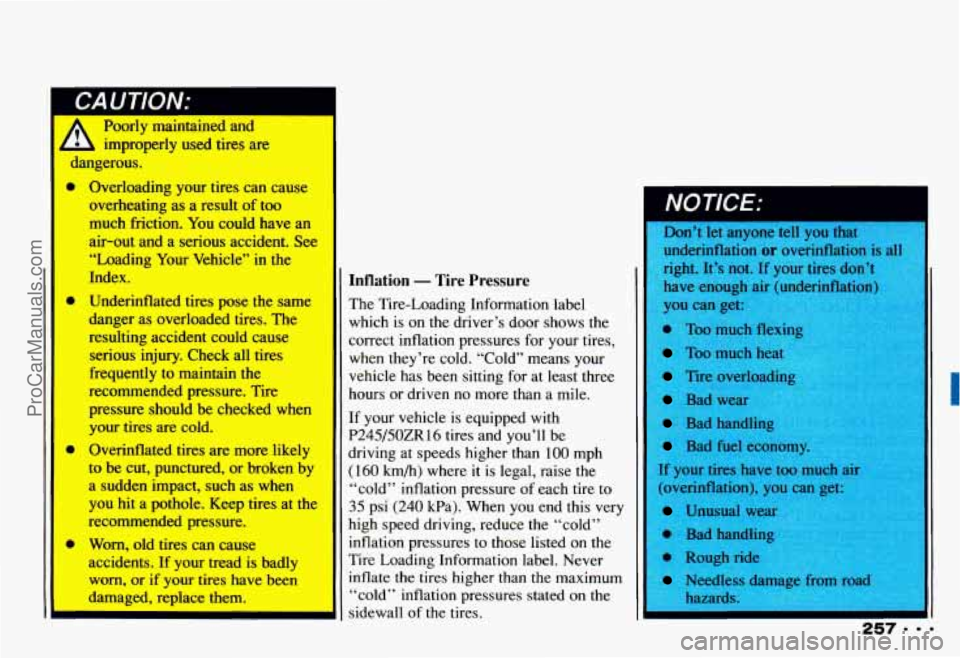
CAUTION:
Poorly maintained and
improperly used tires are
dangerous.
a
m
a
Overloading your tires can cause
overheating as
a result of too
much friction. You could have
an
air-out and a serious accident. See
“Loading Your Vehicle” in the
Index.
Underinflated tires pose the
same
danger as overloaded tires. The
resulting accident could cause
serious
injury. Check all tires
frequently to maintain the
recommended
pressure. Tire
pressure should
be checked when
your tires are cold.
Overinflated tires
are more likely
to be cut, punctured, or broken by
a sudden impact, such as when
you
hit a pothole. Keep tires at the
recommended pressure.
Worn, old tires can cause
accidents.
If your tread is badly
worn, or if your tires have been
damaged, replace them.
I
Inflation - Tire Pressure
The Tire-Loading Information label
which
is on the driver’s door shows the
correct inflation pressures for your tires,
when they’re cold. “Cold” means your
vehicle has been sitting for at least three
hours or driven no more than a mile.
If your vehicle is equipped
with
P245/50ZR16 tires and you’ll be
driving at speeds higher than
100 mph
(160 km/h) where it is legal, raise the
“cold” inflation pressure of each tire to
35 psi (240 kPa). When you end this very
high speed driving, reduce the “cold”
inflation pressures to those listed on the
Tire Loading Information label. Never
inflate the tires higher than the maximum
“cold” inflation pressures stated on the
sidewall of the tires. Don’t let anyone tell
you that
underinflation
or overinflation is all
right. It’s not.
If your tires don’t
haveenougha
n)
you can get
e Too muc
Too much heal
Tire overloading
Bad wear
Bad handli
Bad fuel econ
I If your tires have too much air
(overinflation), you
can get’
Unusual wear
’ 0 Bad handling
e Rough ri,,
Needless damage fi~111
hazards.
~
I
ProCarManuals.com
Page 262 of 358
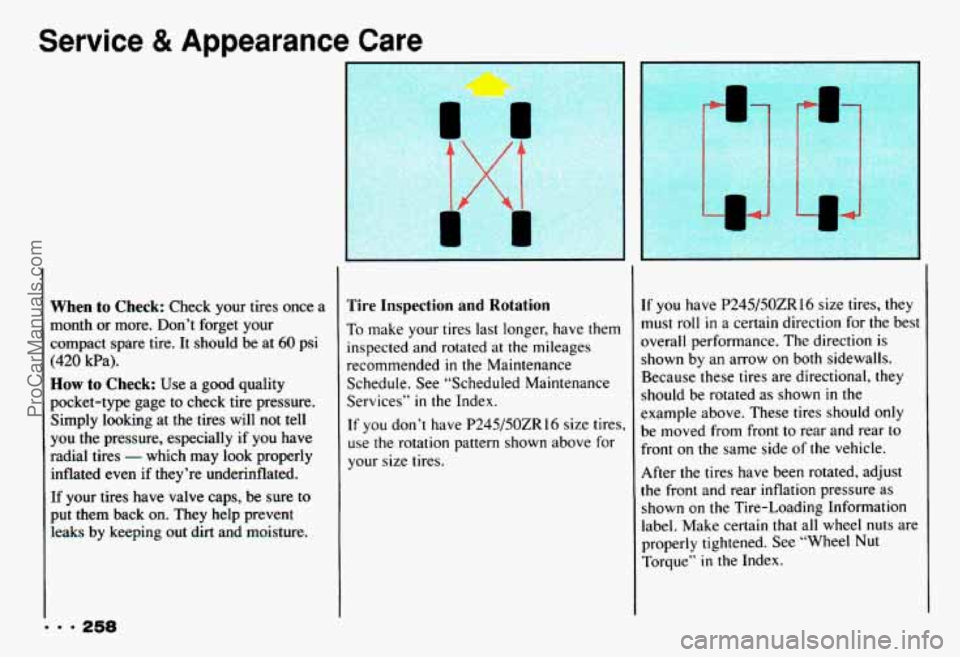
Service & Appearance Care
9 9 9 258
When to Check: Check your tires once a
month
or more. Don’t forget your
compact spare tire. It should be at
60 psi
(420 kPa).
How to Check: Use a good quality
pocket-type gage to check tire pressure.
Simply looking at the tires will not tell
you the pressure, especially if you have
radial tires
- which may look properly
inflated even if they’re underinflated.
If your tires have valve caps, be sure to
put them back on. They help prevent
leaks by keeping out
dirt and moisture.
L
’
Tire Inspection and Rotation
To make your tires last longer, have them
inspected and rotated at the mileages
recommended
in the Maintenance
Schedule. See “Scheduled Maintenance
Services”
in the Index.
If you don’t have
P245/50ZR 16 size tires,
use the rotation pattern shown above for
your size tires. If
you have P245/50ZR16 size tires, they
must roll
in a certain direction for the best
overall performance. The direction is
shown by an arrow on both sidewalls.
Because these tires are directional, they
should
be rotated as shown in the
example above. These tires should only
be moved from front to rear and rear to
front on the same side of the vehicle.
After the tires have been rotated, adjust
the front and rear inflation pressure as
shown on the Tire-Loading Information
label. Make certain that all wheel nuts are
properly tightened. See “Wheel
Nut
Torque” in the Index.
ProCarManuals.com
Page 263 of 358
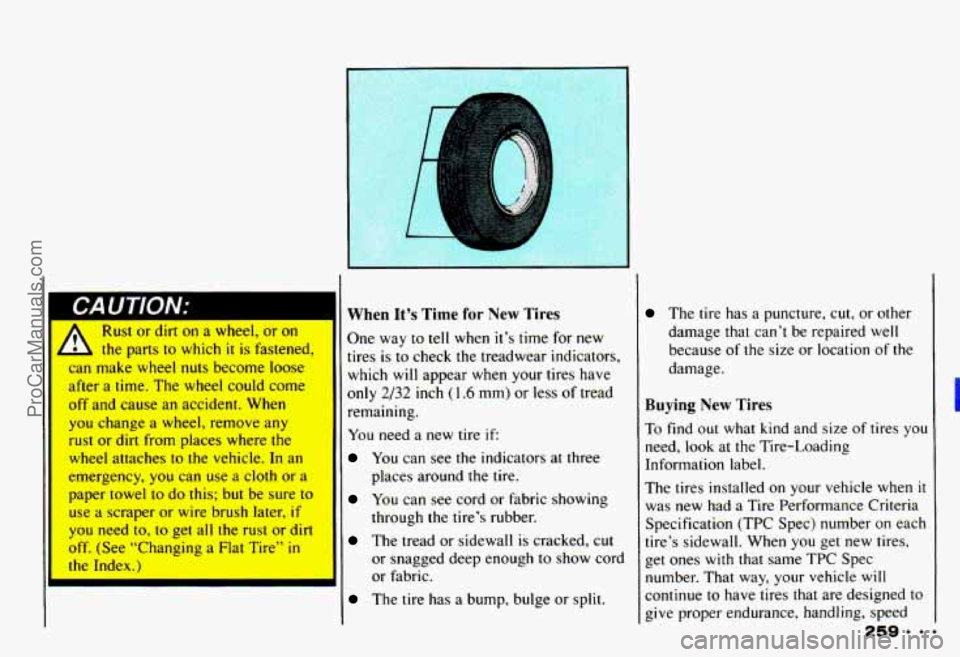
Rust or dirt on a wheel, or on
- the parts to which it is fastened,
can make wheel
nuts become loose
after a time. The wheel could come
off and cause an accident. When
you change a wheel, remove any
rust
or dirt from places where the
wheel attaches
to the vehicle. In an
emergency,
you can use a cloth or a
paper towel to do this; but be sure to
use a scraper
or wire brush later, if
you need to, to get all the rust or dirt
off. (See “Changing
a Flat Tire” in
When It’s Time for New Tires
One way to tell when it’s time for new
tires
is to check the treadwear indicators,
which will appear when your tires have
only
2/32 inch (1.6 mm) or less of tread
remaining.
You need a new tire if:
You can see the indicators at three
places around the tire.
through the tire’s rubber.
or snagged deep enough to show cord
or fabric.
You can see cord or fabric showing
The tread or sidewall is cracked, cut
The tire has a bump, bulge or split.
The tire has a puncture, cut, or other
damage that can’t be repaired well
because
of the size or location of the
damage.
Buying New Tires
To find out what kind and size of tires you
need, look at the Tire-Loading
Information label.
The tires installed on your vehicle when
it
was new had a Tire Performance Criteria
Specification (TPC Spec) number
on each
tire’s sidewall. When you get new tires,
get ones
with that same TPC Spec
number. That way, your vehicle
will
continue to have tires that are designed to
give proper endurance, handling, speed
ProCarManuals.com
Page 264 of 358
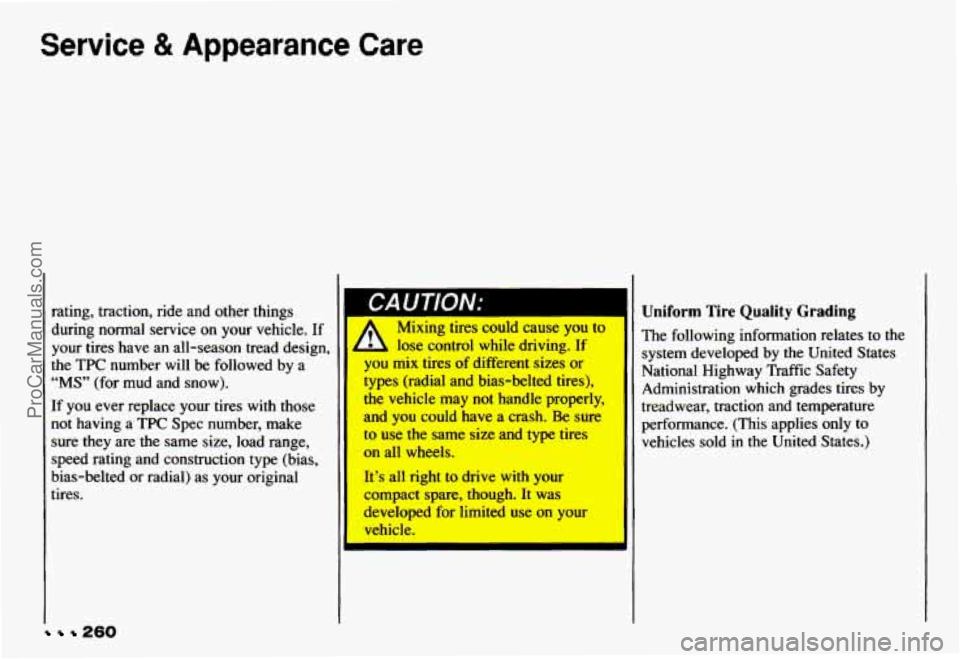
Service & Appearance Care
I
1
260
rating, traction, ride and other things during normal service on your vehicle. If
your tires have an all-season tread design,
&he
TPC number will be followed by a
“MS” (for mud and snow).
If you ever replace your tires with those
not having a TPC Spec number, make
sure they are the same size, load range, speed rating and construction type (bias,
bias-belted or radial) as your original
tires.
I bA u I /w/v.-
Mixing tires could cause you to
you mix tires of different sizes or
the vehicle may not handle properly,
and you could have a crash. Be sure
to use the same size and type tires
on all wheels,
It’s all right to drive with your
compact spare, though. It was
developed for limited use on your
vehicle.
typs
(radial ad bias-belted tires),
Uniform Tire Quality Grading
The following information relates to the
system developed
by the United States
National Highway Traffic Safety
Administration which grades tires by
treadwear, traction and temperature
performance.
(This applies only to
vehicles sold in the United States.)
ProCarManuals.com
Page 265 of 358
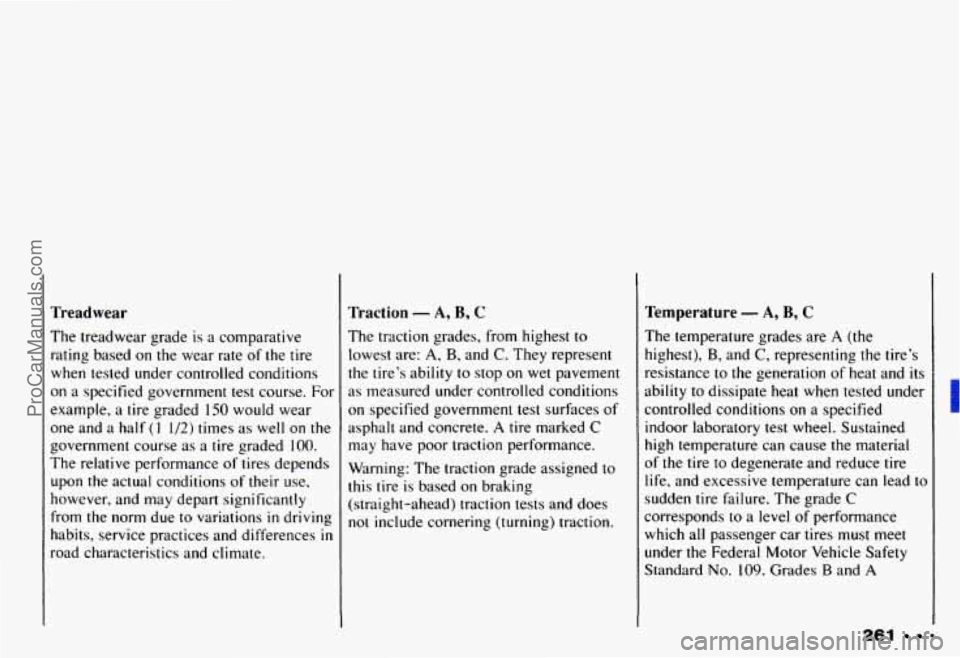
Treadwear
The treadwear grade is a comparative
rating based on the wear rate of the tire
when tested under controlled conditions
on a specified government test course. For
example, a tire graded
150 would wear
one and a half
(1 1/2) times as well on the
government course as a tire graded
100.
The relative performance of tires depends
upon the actual conditions of their use,
however, and may depart significantly
from the norm due
to variations in driving
habits, service practices and differences
in
road characteristics and climate.
Traction - A, B, C
The traction grades, from highest to
lowest are:
A, B, and C. They represent
the tire’s ability
to stop on wet pavement
as measured under controlled conditions
on specified government test surfaces of
asphalt and concrete.
A tire marked C
may have poor traction performance.
Warning: The traction grade assigned
to
this tire is based on braking
(straight-ahead) traction tests and does
no1 include cornering (turning) traction.
Temperature - A, B, C
The temperature grades are A (the
highest),
B, and C, representing the tire’s
resistance to the generation of heat and
its
ability to dissipate heat when tested under
controlled conditions on a specified
indoor laboratory test wheel. Sustained
high temperature can cause the material
of the tire to degenerate and reduce tire
life, and excessive temperature can lead to
sudden tire failure. The grade
C
corresponds to a level of performance
which all passenger car tires must meet
under the Federal Motor Vehicle Safety
Standard
No. 109. Grades B and A
261
ProCarManuals.com
Page 266 of 358
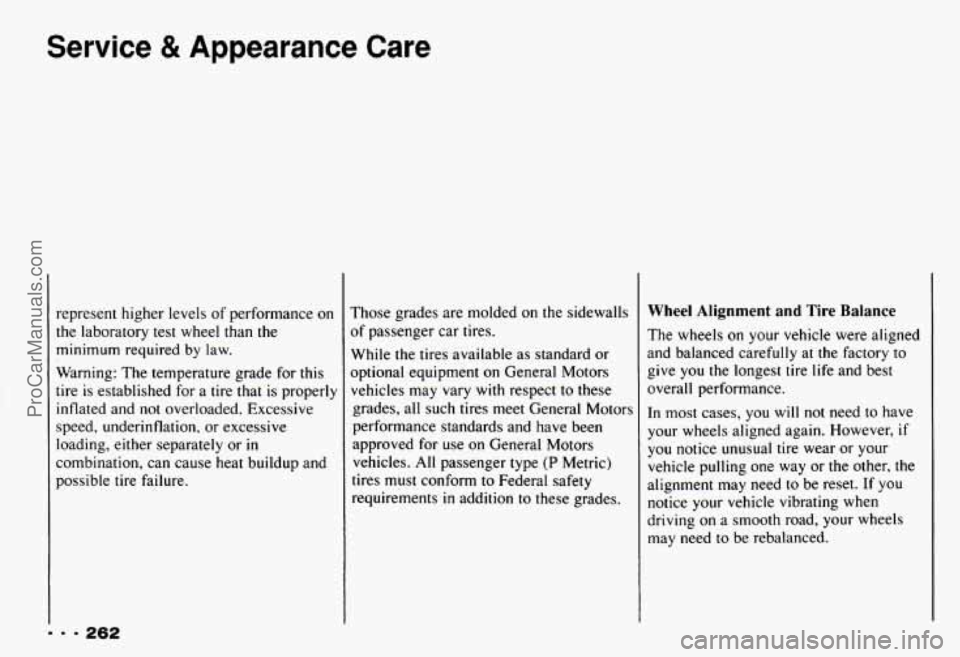
Service & Appearance Care
represent higher levels of performance on
the laboratory test wheel than the
minimum required by law.
Warning: The temperature grade for this
tire is established for a tire that is properly
inflated and not overloaded. Excessive
speed, underinflation, or excessive
loading, either separately or
in
combination, can cause heat buildup and
possible tire failure. Those grades
are molded on the sidewalls
of passenger car tires.
While the tires available as standard or
optional equipment on General Motors
vehicles may vary with respect to these
grades, all such tires meet General Motors
performance standards and have been
approved for use
on General Motors
vehicles.
All passenger type (P Metric)
tires must conform
to Federal safety
requirements
in addition to these grades.
Wheel Alignment and Tire Balance
The wheels on your vehicle were aligned
and balanced carefully at the factory to
give you the longest tire life and best
overall performance.
In most cases, you will not need to have
your wheels aligned again. However,
if
you notice unusual tire wear or your
vehicle pulling one way or the other, the
alignment may need to be reset.
If you
notice your vehicle vibrating when
driving on a smooth road, your wheels
may need to be rebalanced.
... 262
ProCarManuals.com
Page 267 of 358
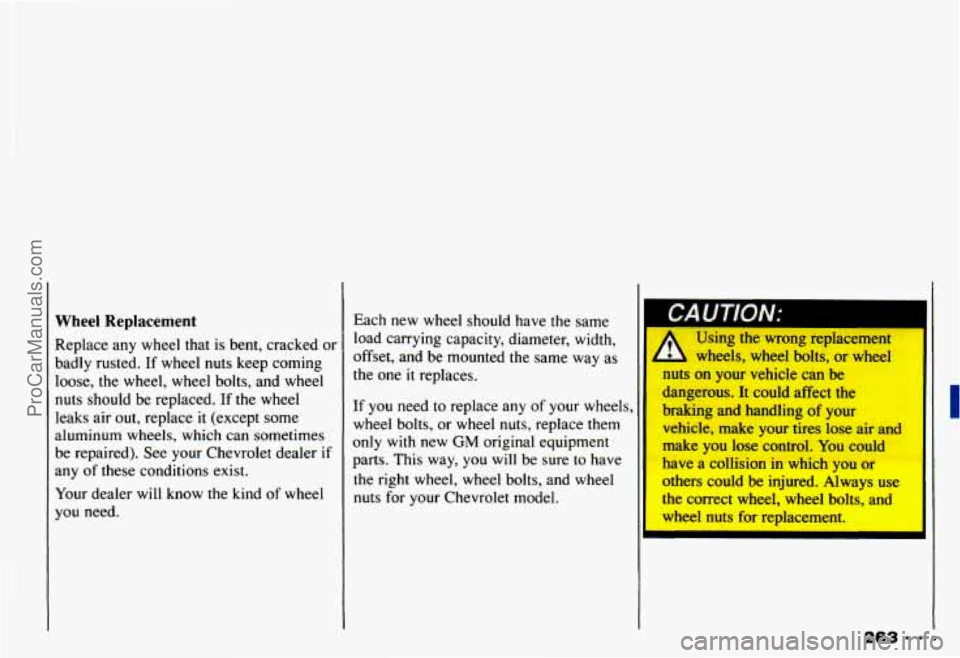
Wheel Replacement
Replace any wheel that is bent, cracked or
badly rusted.
If wheel nuts keep coming
loose, the wheel, wheel bolts, and wheel
nuts should be replaced. If the wheel
leaks air out, replace
it (except some
aluminum wheels, which can sometimes
be repaired). See your Chevrolet dealer
if
any of these conditions exist.
Your dealer
will know the kind of wheel
you need. Each new wheel should have the same
load carrying capacity, diameter, width,
offset, and be mounted the same way as
the one it replaces.
If you need to replace any of your wheels,
wheel bolts, or wheel nuts, replace them
only with new
GM original equipment
parts. This way, you
will be sure to have
the right wheel, wheel bolts, and wheel
nuts for your Chevrolet model.
CAUTION:
Using th-t
wheels, wheel bolts, or wheel
nuts on your vehicle can be
dangerous. It could affect the
braking and handling
of your
vehicle, make your tires lose air and
make you lose control.
You could
have
a collision in which you or
others could be injured. Always use
the correct wheel, wheel bolts, and
wheel nuts for replacement.
263 = 9
ProCarManuals.com
Page 268 of 358
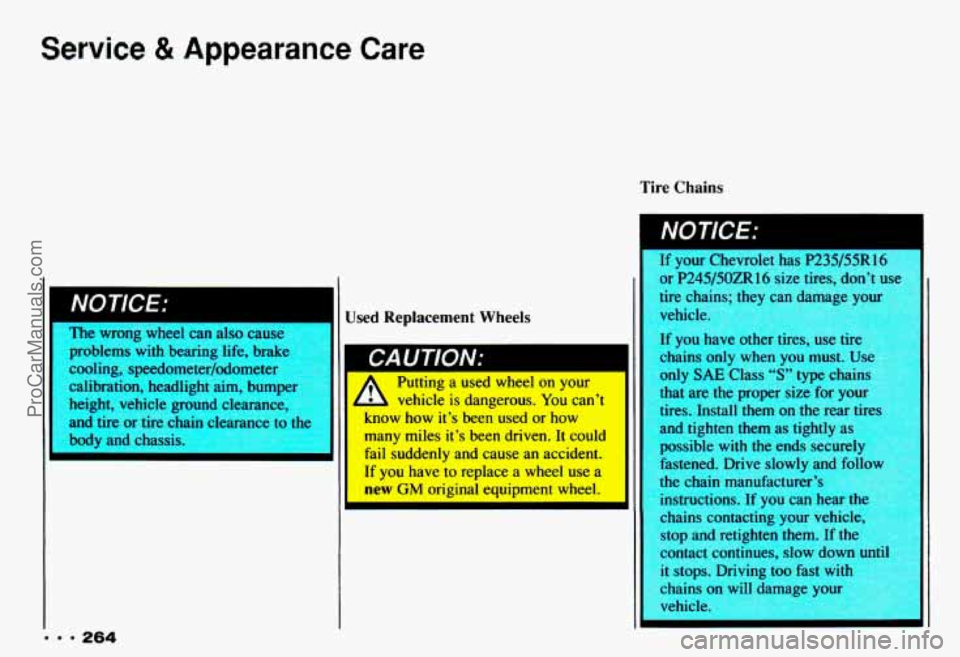
Service & Appearance Care
Tire Chains
IL
The wrong wheel can also cause
problems with bearing life, brake
cooling, speedometer/odometer
y!g@
calibration, headlight aim, bumper32
‘ i.i _. /8*
. .I )
height, vehicle ground clearance,
and tire or tire chain clearance to the
body and chassis. 1
... 264
Used Replacement Wheels
ruwllg it uscu WIIGGI UII yuul
vehicle is dangerous. You can’t
nnOW how it’s been used or how
many miles it’s been driven. It could
fail suddenly and cause an accident.
If you have to replace a wheel use a
new GM original equipment wheel.
Ib
If your Chevrolet has P235/55R16
or
P245/50ZRlf; cize tire. don’t 11c~ I
tire chains: the --In dm e vow I
I
vehicle.
If
you ,.-ve other tires, “st; LIIC
chains only when you must. Use
only
SAE Class “S” type chains
that are the proper size for
y
tires. Install them on the rear tires
and tighten them as tightly as
possible
with the ends securel)
fastened. Drive slowly and
folio
stop and retighten them. If the I
the chain manufacturer’s
instructions.
If you can hear th
chains contacting your vehicle
contact continues, slow down until
I
it stops. Driving too fast wit
chains on will damage yourg
vchicle.
I
ProCarManuals.com
Page 269 of 358
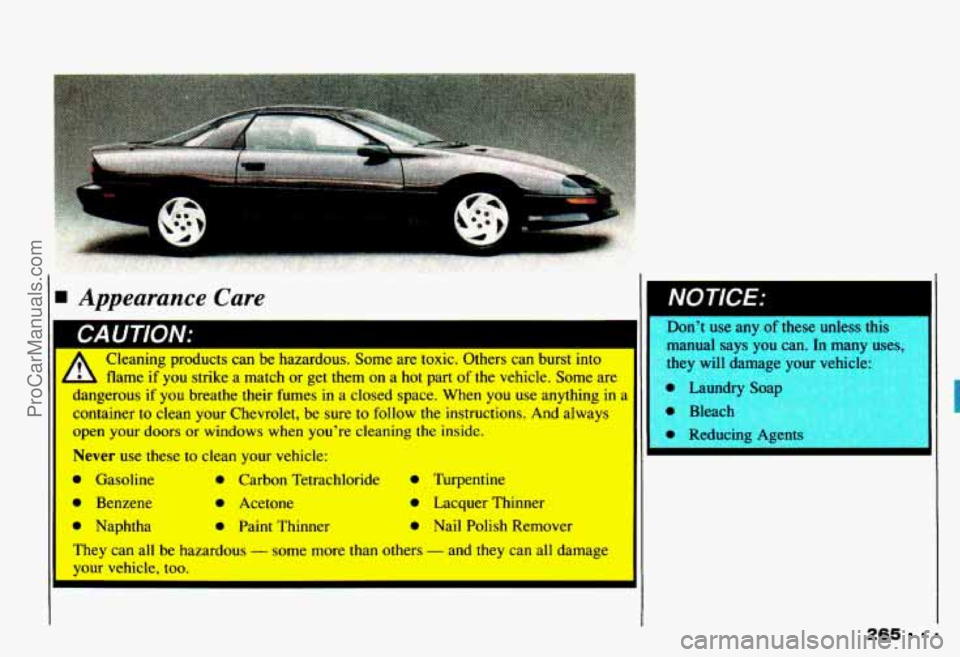
A r!eaning products can be hazardous. Some are toxic. mers can burst into
- me if you strike a match or get them on a hot part of the vehicle. Some a=
d zerous if you breathe their fumes in a closed space. When you use anything
container to clean your Chevrokt, be sure to follow the instructions. And always
open your doors or windows when you’re cleaning the inside.
Never use these to clean your vehicle:
a Gasoline @ Carbon Tetrachloride Turpentine
Benzene @ Acetone m Lacquer Thinner
* Naphtha @ Paint Thinner Nail Polish Remover
They can all be hazardous - some more than others - and they can all damage
your vehicle, too.
Don’t use any of these unless this
manual says you can. In many
uses: &’---- will damage your vehicle:
’aP
0
0
leach
0 Reducing Agents
265 -
ProCarManuals.com
Page 270 of 358
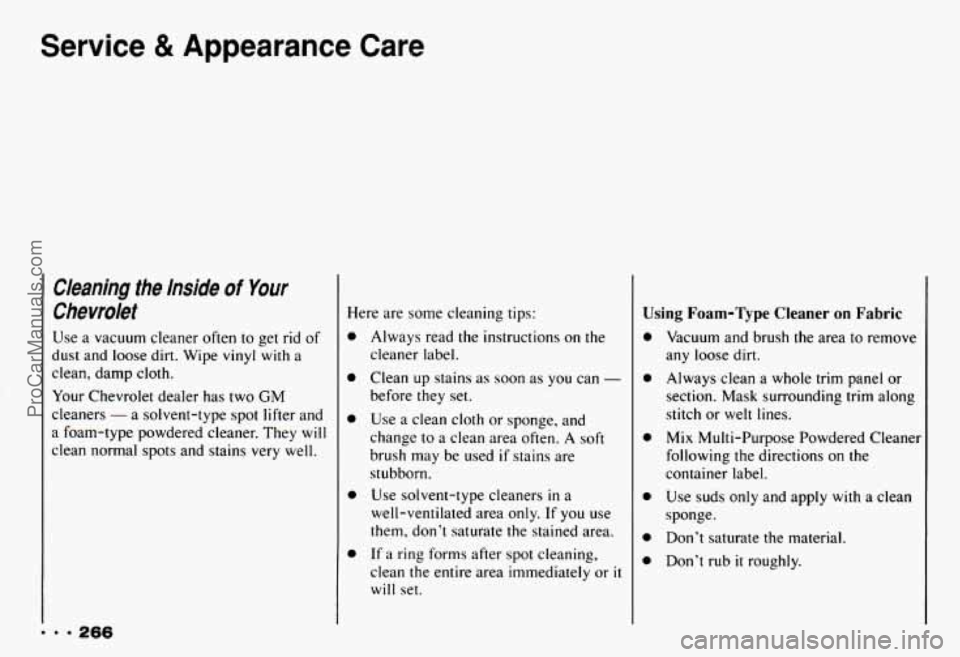
Service & Appearance Care
m.. 266
Cleaning the Inside of Your
Chevrolet
Use a vacuum cleaner often to get rid of
dust and loose dirt. Wipe
vinyl with a
clean, damp cloth.
Your Chevrolet dealer has two
GM
cleaners - a solvent-type spot lifter and
a foam-type powdered cleaner. They
will
clean normal spots and stains very well. Here are some cleaning tips:
0 Always read the instructions
on the
cleaner label.
Clean up stains
as soon as you can -
before they set.
Use a clean cloth or sponge, and
change to a clean area often.
A soft
brush
may be used if stains are
stubborn.
Use solvent-type cleaners
in a
well-ventilated area only. If you use
them, don’t saturate the stained area.
If
a ring forms after spot cleaning,
clean the entire area immediately or
it
will set.
Using Foam-Type Cleaner on Fabric
0
Vacuum and brush the area to remove
any loose
dirt.
Always clean a whole trim panel or
section. Mask surrounding trim along
stitch or welt lines.
Mix Multi-Purpose Powdered Cleaner
following the directions on the
container label.
Use suds only and apply
with a clean
sponge.
Don’t saturate the material.
Don’t rub
it roughly.
ProCarManuals.com